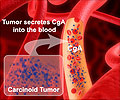
"The MAPK pathway has been the subject of intense research to develop inhibitors against components of the pathway for the treatment of cancer," said Ahmed Samatar, Ph.D., team leader of discovery oncology at Merck Research Laboratories. "Unfortunately, tumor responses are often transient and resistance to therapy is commonly associated with pathway reactivation involving the downstream module ERK1/2."
Samatar and colleagues hypothesized that inhibiting ERK in tumor cells driven by an activated MAPK pathway, as a result of either BRAF or RAS mutations, could provide a means of inhibiting tumor cell growth. The researchers used SCH772984, a novel ERK inhibitor, to test this theory.
Their results indicated that SCH772984 was a potent inhibitor of ERK1/2 in cultured human tumor cells with mutations in BRAF, NRAS or KRAS. The drug also induced tumor regression when tested in mouse models.
In addition, SCH772984 inhibited MAPK signaling and cell proliferation in human tumor cells resistant to BRAF and MEK inhibitors alone or in combination.
"Patients with cancer treated with BRAF and/or MEK inhibitors are susceptible to the development of resistance primarily via reactivation of ERK," Samatar said. "ERK inhibitors may provide a means to treat patients with these drug-resistant tumors, and an ERK inhibitor in combination with a BRAF or MEK inhibitor may also provide a strategy to overcome drug resistance."
Advertisement
About the American Association for Cancer Research
Founded in 1907, the American Association for Cancer Research (AACR) is the world's first and largest professional organization dedicated to advancing cancer research and its mission to prevent and cure cancer. AACR membership includes more than 34,000 laboratory, translational and clinical researchers; population scientists; other health care professionals; and cancer advocates residing in more than 90 countries. The AACR marshals the full spectrum of expertise of the cancer community to accelerate progress in the prevention, biology, diagnosis and treatment of cancer by annually convening more than 20 conferences and educational workshops, the largest of which is the AACR Annual Meeting with more than 17,000 attendees. In addition, the AACR publishes eight peer-reviewed scientific journals and a magazine for cancer survivors, patients and their caregivers. The AACR funds meritorious research directly as well as in cooperation with numerous cancer organizations. As the scientific partner of Stand Up To Cancer, the AACR provides expert peer review, grants administration and scientific oversight of team science and individual grants in cancer research that have the potential for near-term patient benefit. The AACR actively communicates with legislators and policymakers about the value of cancer research and related biomedical science in saving lives from cancer. For more information about the AACR, visit AACR.org.
Advertisement
Presenter: Ahmed Samatar, Ph.D.
Title: A novel ERK inhibitor is active in models of acquired resistance to BRAF and MEK inhibitors
Authors: Ahmed A. Samatar, Erick J. Morris, Sharda Jha, Restaino R. Clifford, Bart Luttrerbach, Marc Pelletier, Ulrike Philippar, Lata Jayaraman, Leigh Zawel, Steve Fawell, Gary Gilliland. Merck Research Laboratories, Boston, MA
The high frequency of activating BRAFV600E mutations in melanoma (40-70%), thyroid (50%) and colorectal cancer (10%), or KRAS/NRAS mutations in melanoma (20%), pancreatic (90%), colorectal (50%) and non-small cell lung cancer (30%), provides strong rationale for targeting the MAPK pathway as a therapeutic strategy 1-6. Vemurafenib (PLX4032) and dabrafenib (GSK2118436), selective BRAF inhibitors, and trametinib (GSK1120212), an allosteric MEK inhibitor, have shown robust clinical efficacy in melanoma patients 7-10. However, the majority of responses are transient and cellular resistance is often associated with pathway reactivation involving the downstream extracellular-signal-regulated kinases 1 and 2 (ERK1/2) (reviewed in 11). We hypothesized that pathway blockade at ERK, the last signaling node prior to MAPK transcriptional programming, would not only be efficacious in MAPK-activated tumors but would also have utility in BRAF or MEK inhibitor resistant settings. We therefore sought to identify small molecule inhibitors of ERK. This report describes the identification and characterization of SCH772984, a potent and selective ATP competitive inhibitor of ERK1/2 which displays behaviors of both type I and type II kinase inhibitors. SCH772984 has nanomolar cellular potency on tumor cells with mutations in BRAF, NRAS, or KRAS and induces tumor regressions in xenograft models at tolerated doses. Importantly, SCH772984 effectively inhibited MAPK signaling and cell proliferation in BRAF or MEK inhibitor resistant models as well as in the context of BRAF/MEK combination resistance. Together these data support the clinical development of ERK inhibitors, not only in patients with MAPK activated tumors, but also in patients who have developed acquired resistance to BRAF or MEK inhibitors or resistance to the recently described combination of these agents.
Source-Newswise











